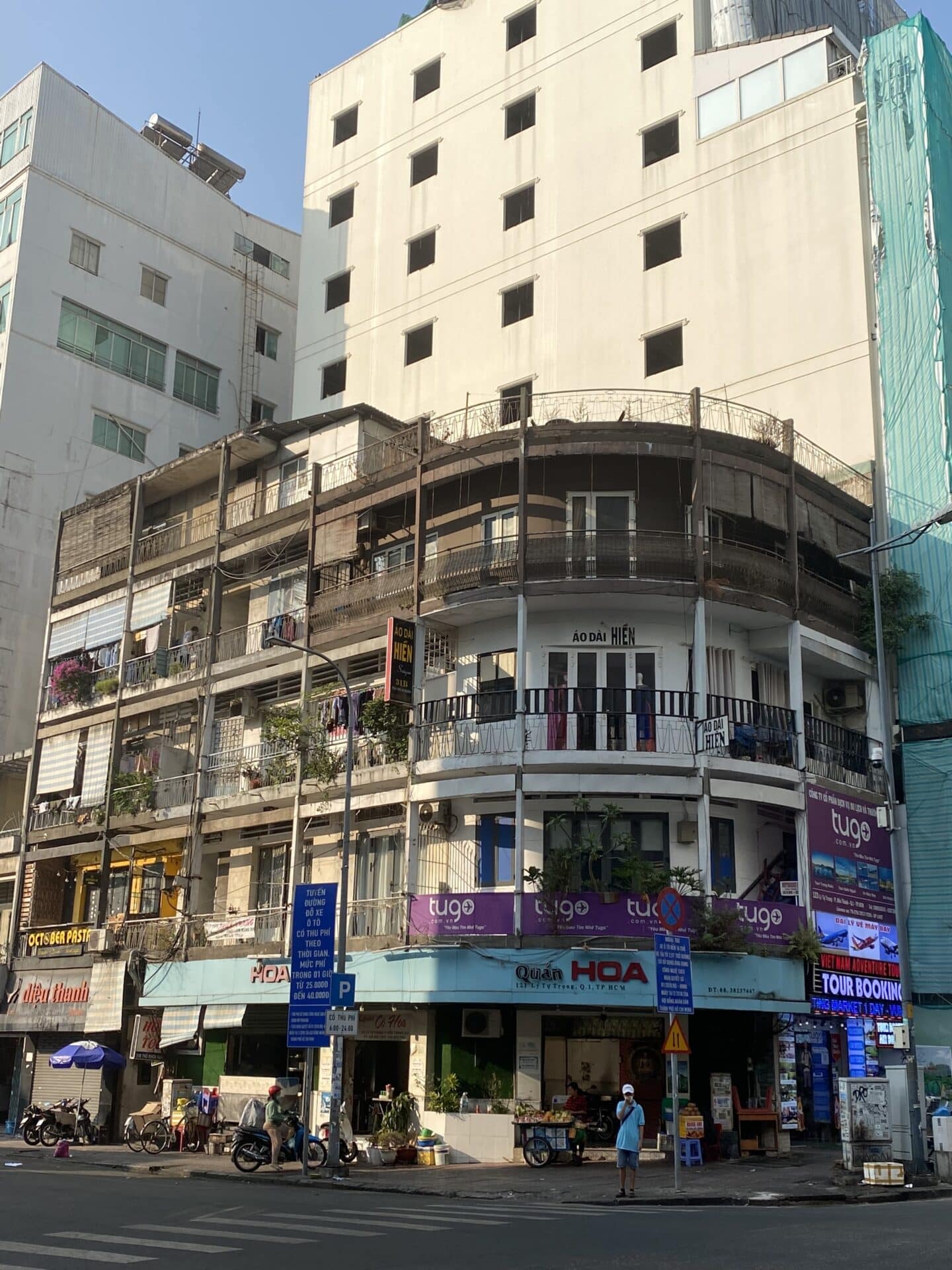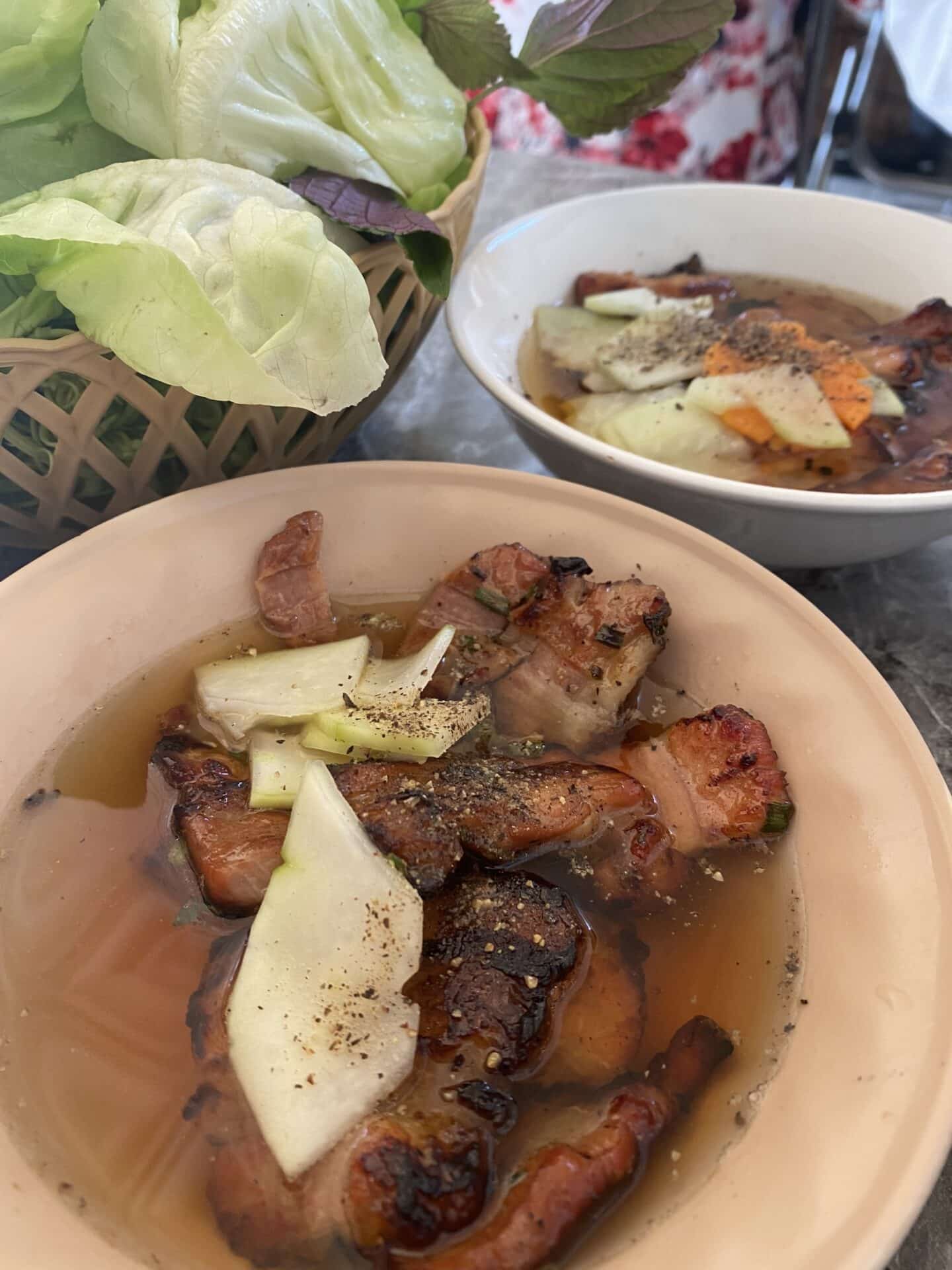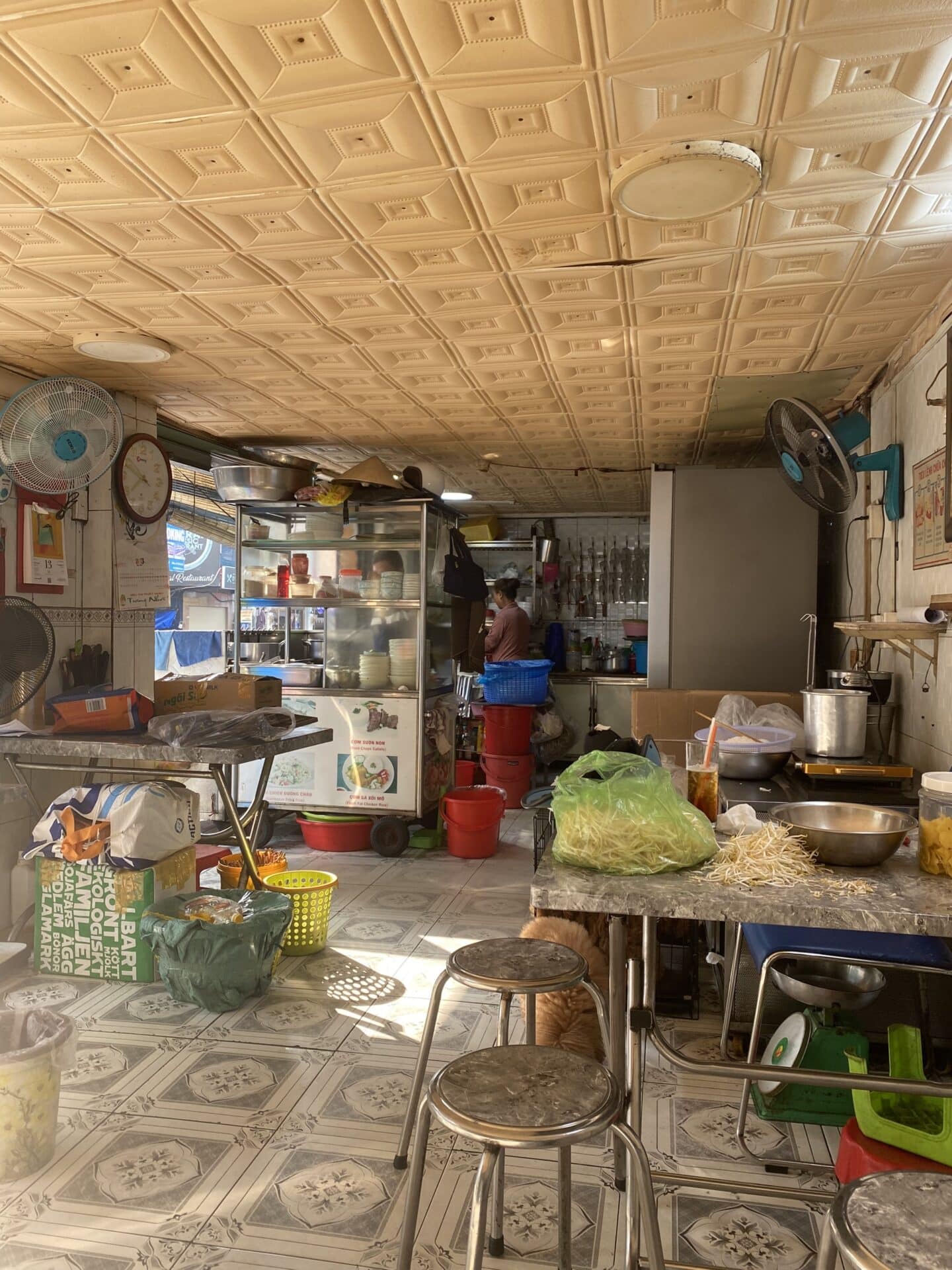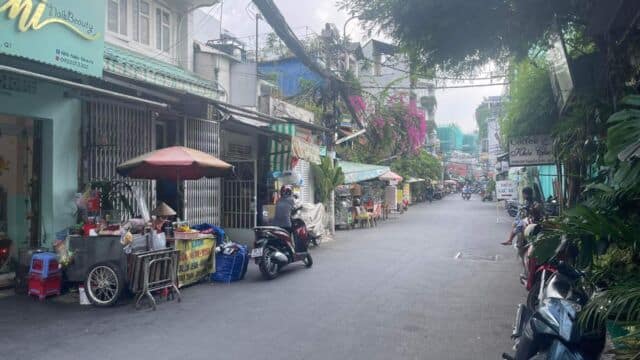Same Bun Cha, Different Tony From New York
Photo: Anh Nguyen/Unsplash
Hoa Đông Restaurant | 2,500 words
Translated from Vietnamese by Ally Le
At the end of 2022, a fire broke out near Bến Thành Market in the daytime. In the images on live broadcast I was surprised to see, from various angles, the shophouses lining Thủ Khoa Huân Street and its intersection with Lý Tự Trọng Street. I used to be quite familiar with this area.
What struck me most was a four-storey house by the street corner, standing modestly, all but swallowed up by the surrounding blocks of crude cubic architecture.
Billboards advertising travel tours or áo dài tailoring services covered nearly all its balconies, greyed by the passage of time, but they still couldn’t gloss over the building’s air of obsolescence and lostness compared to its immediate environs. The building was old, crude and ugly – just like the restaurant on its ground floor. That restaurant’s doors I saw were flung wide open, as if intentionally exposing how out of date its interior décor and furniture were. Its sign wasn’t any better, it looked both sparse and crass, the restaurant’s name itself the only text, curtly standing out in a font that was trying to be half-nostalgic, half-modern: Hoa Restaurant.
I could explain more about this name – and why the full name, Hoa Đông Restaurant, is not written on the sign – for anyone interested. I would have told Tony, had he wanted to know.
When Tony came to Hồ Chí Minh City, I recalled the bewilderment of a Vietnamese American relative, living in Orange County, California, when she took us to Disneyland – and I couldn’t help but feel sympathy for her. That was the first time she had bought tickets to Disneyland after settling in the United States more than fifteen years earlier. I felt sympathetic because I myself had fallen into the same predicament with Tony. It’s sometimes only when you have to play “tour guide” and introduce your city to visitors from far away that you realize how strange and distant it feels to you.
In the situation I was in, clearly a Patrick Modiano of Paris or an Orhan Pamuk of Istanbul would be completely useless. I was now in need of an Anthony Bourdain of Hồ Chí Minh City. I say Anthony Bourdain because I was playing culinary tour guide for Tony. Moreover, the dish we decided to try was bún chả, Vietnamese grilled pork with rice vermicelli noodles.

Of course, had Tony not come from New York, like Bourdain, and had not mentioned former President Obama so much, I would not have had the urge to recommend bún chả to him. As everyone knows, Obama and Bourdain had sat down for a meal of bún chả in Hanoi.
Tony’s the same age as me, and is the son of my father’s best friend. He had just arrived from the US for a short visit: it was our first time meeting. In Hồ Chí Minh City he was wearing casual dress, plain T-shirt, jeans or shorts, and sneakers. His clothes confirmed he wasn’t a local, given that locals as they move around on their motorbikes wear thick outerwear to block the heat. Tony was bigger than me, maybe 10 or 20 kilograms heavier, and we were nearly the same height.
He had been enjoying eating different food in Hồ Chí Minh City, though most Vietnamese Americans like him seem to come to Vietnam to accompany their parents, not because they’re actually excited about the place.
Saigon, the former name of Hồ Chí Minh City, was where both our families had lived for many, many years. The special thing about this city is that even residents who might have lived here for a very long time, like my family, are just migrants, in the end.
My father came to Saigon in the late 1960s, around the same time as Tony’s father. Roughly ten years later, Tony’s family fled Vietnam and settled in America.
In hindsight, my family has been here forever – just like the building that houses Hoa Đông Restaurant. However, when asked, I always say my hometown is in Quảng Nam, whereas my mother, who was born and grew up in this city, still maintains that her hometown is in Vĩnh Long.
We may say that Saigonese are more or less all migrants, and in my view, one of the extraordinary characteristics of Saigon is diversity. Everything is drawn into this place, co-existing, converging and merging, all at once.
That’s why bún chả, originally a culinary specialty of Hanoi, in the north of Vietnam, can be easily found in Saigon.
Hoa Đông Restaurant, which has been serving bún chả for over half a century, was where we were headed today, though Tony wasn’t particularly excited about this dish. Seems it was a little too oily for his taste.
*
Inside Hoa Đông Restaurant, I had my bún chả while Tony munched on a plate of saltwater crab spring rolls.
“Why did Obama choose bún chả on that day?” I asked.
“The truth is, Bourdain had recommended xôi gà but Michelle preferred that her husband have bún chả.” Tony’s slanting eyebrows with crooked tails create an impression of unmistakable humor in anyone coming face-to-face with him. “You know who the real boss at the White House was?”
I had already noticed that Tony liked to talk about US politics all the time. I could follow along because I follow American politics to some extent.
“Oh, and you know that all those ‘local Vietnamese’ customers sitting in the restaurant with them that day, were actually security personnel?” Tony said, his eyebrow tails perking up.
“Security personnel?” I said, and suddenly looked around. The few customers sitting inside Hoa Đông Restaurant right now were all elderly people who looked harmless enough.
Tony pointed to an elderly lady with grey and curly hair who sat grilling the meat. The pork at Hoa Đông Restaurant is famous for being grilled on bamboo skewers made from aged bamboo sheaths that are harder to catch fire. Grilled meat is what makes the soul of bún chả, next to the rice vermicelli noodles, vegetables, and fish sauce.
“If I were Michelle’s security team, I would cosplay this lady,” Tony said.
“That’s the owner of this restaurant,” I laughed.
I had an urge to point out to Tony more of the history and culture on display in this restaurant, the surrounding streets, and the wider city. I’m passionate about these topics myself. I also thought Tony should be interested in such things as somebody who used to live here, even though it was a long time ago. So in front of him, I said hello to the restaurant owner and asked about her wellbeing. A lady named Hoa, she started telling stories.
Hoa Đông Restaurant dates back to Mrs. Hoa’s mother-in-law, who was a peddler in the late 1950s. She had moved to Saigon from North Vietnam, just like the other million émigrés who left in 1954 after the Geneva Accords divided Vietnam into two halves. Then in 1975 after the two halves of Vietnam were reunified, many on the war’s losing side, including those Northern émigrés who had left for the South in 1954, like Tony’s family, had to keep emigrating.
Mrs. Hoa’s mother-in-law used to live with her family on Khâm Thiên Street, Hanoi. Initially after her move to Saigon, she peddled on Lê Lợi Street, then moved to Lê Thánh Tôn Street near Bến Thành Market. Later, Mrs. Hoa took over from her mother-in-law and opened a store on Thủ Khoa Huân Street, but on the opposite side of the road. Hoa Đông Restaurant has been located in its current building for more than ten years now.
Mrs. Hoa said that her restaurant has a large number of regulars, and many visits by overseas Vietnamese who once lived in this area.
“This guy here is also an overseas Vietnamese.” I pointed to Tony who, at that moment, seemed invested in the conversation.
Tony politely exchanged a few sentences with Mrs. Hoa in an awkward, adorable Vietnamese, like a child with a lisp. Mrs. Hoa went on talking, her elderly voice trembling a little, yet managing to retain the speed and sharpness of a veteran who had been doing business near this market for many years.
She said the restaurant might look sparse now, as if business was slow, but come Lunar New Year, many customers would order spring rolls in large quantities, fifty or even a hundred rolls.

I asked her to talk more about her mother-in-law. Mrs. Hoa only said that her mother-in-law had gone to live in the United States on the family reunification scheme a long time ago. I went on to ask more, wondering why Mrs. Hoa speaks with a Southern accent – but perhaps the story was too personal, as she feigned ignorance and continued busily tending to her work.
I looked to Tony for a response to this interaction.
“Nice conversation, very natural. If she had played the role of the security detail, Michelle, or perhaps Barack Obama, would be very proud,” Tony said, still not having finished his saltwater crab spring rolls.
That type of spring roll is larger and rounder than the normal type, which is why they are usually cut into quarters to make them easier for customers to eat. Looking at the messy spring rolls on Tony’s plate, I pondered the act of leaving one’s homeland behind, and the multitude of people who have come from different places to gather in Saigon.
I picked up our conversation and told Tony about the stores and shops opened by the Northern émigrés around this area.
Advancing further from Trương Định Street, Ngọc Sáng is a traditional bakery that has survived after many decades. Their round baguettes stuffed with cold cuts and jambon are a bestseller. I also like their pâté chaud. Among the owners, who are sisters from the same family, one still lives in this city and is a lifelong member of a choir at the Notre Dame Cathedral Basilica of Saigon.
I looked to Tony for a response. He nodded.
Continue walking near Thủ Khoa Huân Street and you’ll find Bảo Hiên Golden Dragon store. This bakery traces its origins to Hải Dương Province and is extremely well-known for its mung bean cakes, which were popular gifts among Saigonese around ten or twenty years ago.
I noticed Tony’s flat facial expression.
Following along Lý Tự Trọng Street in the direction of Gia Long Palace, you’ll encounter Minh Châu store on the left, which sells Vietnamese-style sausages. This might be the busiest store in this area at present. Their landlord, who is also a family member, turns out to be another Northern émigré.
As I said this, Tony protested: “It seems like historically this area was just full of Northern émigrés. You can’t call that diversity.”
“But right now, almost all the housing here has been taken over by a new wave of Northern migrants, not the old émigrés. Rumour has it that they all come from Haiphong.” I continued: “And before, in this area, there were many Chinese residents as well. They were small merchants plying their trade inside Bến Thành Market and along both sides of Thủ Khoa Huân Street.”
Out of the blue, I remembered my childhood. Once, my parents took me out for shrimp fritters at this same Hoa Đông Restaurant, which was then set up on the opposite pavement, equipped with dilapidated stools. Walking from our house, which used to be on this exact street, to Thủ Khoa Huân Street was a whole journey. The pavements then were crowded with hawkers and vendors. Sometimes I had to walk through places where stagnant water pooled up to my ankles. The street market was like that, full of garbage and blackwater.
Now I told Tony that Bến Thành Market made me think of the Mediterranean Sea. At least back in the days when the market was still bustling with business and wasn’t catering to tourism, when going there likewise meant wading through water. There was the vibrant trade, the nearness of the ocean, the diverse cuisine, the mixing of cultures. I started to talk about Rome, center of ancient civilisations, then compared what I knew of it to this place, the rows of shophouses and restaurants standing wall-to-wall, lining the sides of Lý Tự Trọng Street, Thủ Khoa Huân Street, then Lê Thánh Tôn Street…
Tony didn’t seem to pay much attention to my historical comparison. We might need to dig deeper into the idea of diversity, or return to the topic of a certain reform-minded President, and perhaps then he would turn lively again?
We stood up and left the restaurant. After crossing the road, we both suddenly turned around to look at it. The restaurant’s sign in crude colours, and its shabby furniture, were undeniably fitting with the broader building façade.
Little does anyone know that this building, whose Juliet balconies on all four storeys were designed to hug the street corner, and which has bizarrely slim vertical columns slicing down its front, is a combination of Art Deco architectural elements from the late colonial period and a modernist architecture which was a signature of South Vietnam in the 1960s and 1970s. This design can no longer be found elsewhere.
I guess only experts on urban architecture would concern themselves with this matter. I decided not to tell Tony about this unique detail.
Buildings like this one, that have gone out of style and look out of place, will eventually be demolished and replaced. Even restaurants with deep-rooted history like Hoa Đông will, sooner or later, also disappear. Just by looking at the age of the customers and the age of the owner, I could already foretell the restaurant’s fate.

And perhaps, diversity is also no longer something worthy of discussion in Saigon-Hồ Chí Minh City – by visiting tourists, but by locals, as well.
I told Tony the reason why only “Hoa” was left on the sign of Hoa Đông Restaurant. Last time I was there, Mrs. Hoa had told me that the wind had blown away the letters “Đ” and “g” in “Đông”, but she couldn’t find the same font anymore, so she was just keeping it as “Hoa” for the time being.
Now Tony laughed. “The ‘Đông’ in Hoa Đông Restaurant has gone missing, no wonder business is so slow.”
“Đông” in “Hoa Đông” means “winter”, but “đông” in Vietnamese can also mean “crowded”.
I was surprised. “Since when did your Vietnamese become so good, huh, Tony?”
“Nah, I’m not that great. But I hate wordplay, it’s kinda low, don’t ya think. Like ‘Obamacare’, you know.”
And just like that, Tony became spirited again. He babbled on and on.
Me, I felt sorry for him for refusing to enjoy the bún chả here. It was very delicious.
© Lê Khải Việt
English translation © Ally Le
Commissioning editor: Quyên Nguyễn




